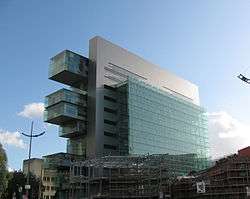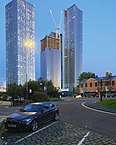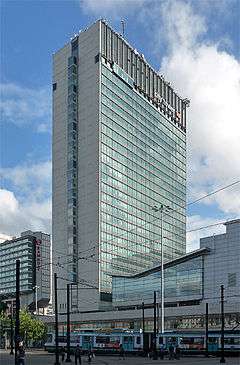Manchester Civil Justice Centre
Manchester Civil Justice Centre is a governmental building in Manchester, England. Completed in 2007, it houses Manchester's county court and the Manchester District Registry of the High Court, the city's family proceedings court, the district probate registry, and the regional and area offices of the Court Service.[3]
| Civil Justice Centre | |
|---|---|
 Manchester Civil Justice Centre, Spinningfields | |

| |
| Alternative names | MCJC |
| General information | |
| Status | Complete |
| Type | High-rise Courts |
| Architectural style | Futurist / Expressionist |
| Location | Spinningfields, Manchester, England |
| Completed | 2007 |
| Cost | £113 million[1] |
| Height | |
| Roof | 80 m (260 ft) |
| Technical details | |
| Floor count | 17 |
| Floor area | 35,160 m2 (378,500 sq ft) |
| Design and construction | |
| Architect | Denton Corker Marshall |
| Developer | Allied London |
| Structural engineer | Mott MacDonald[2] |
| Main contractor | Bovis Lend Lease |
The Civil Justice Centre was the first major court complex built in Britain since George Edmund Street's Royal Courts of Justice in London completed in 1882.[4] Its distinctive architecture has been nicknamed the "filing cabinet" because of its cantilever floors at the end of the building.[5] The design takes inspiration from Expressionist architecture, as well as the artistic Futurist movement of the 1920s which promotes dynamic lines and a sense of fluid movement.
Commissioned by the former Department for Constitutional Affairs (now the Ministry of Justice), the building was funded as a Public–private partnership and is the centrepiece of the Spinningfields development. The building opened to widespread acclaim for its expressionist dynamism, environmental credentials and high-quality design. It was nominated for RIBA's Stirling Prize in 2007 and named one of the "Best British buildings of the 21st century" by Blueprint magazine in 2011.[6]
History
The Justice Centre is in Spinningfields, an area west of the city centre which has been regenerated since the 1996 Manchester bombing. The building was required to provide new court space for Greater Manchester.[7] An international competition managed by RIBA Competitions to design a landmark building to complement the development was launched in 2000. The brief required a minimum floor-plate of 300,000 square feet and flexibility as a potential office building. The competition garnered 100 applicants which was whittled down to 49 long-list proposals.
The competition attracted the attention of major international architecture practices including Foster + Partners, Kohn Pedersen Fox, Nicholas Grimshaw and Partners and Feilden Clegg Bradley - all of which made it to the last 11 short-list.[8] The three finalists were Richard Rogers Partnership, Pringle Richards Sharratt and Denton Corker Marshall.
In August 2002, the design proposal from Australian architects Denton Corker Marshall with engineers Mott MacDonald was announced as the winner.[9] The practice won the competition for the manner in which they maximised the elongated site, the striking yet practical design, clear zoning of space and value for money.[10]
Construction began in 2003, funded by a £160 million public–private partnership deal between developer Allied London and the government.[11] The western side of the 80 metres (260 ft), 17-storey building faces the River Irwell. As of 2017 it is the joint eighth-tallest building in Manchester alongside Manchester One. Its entrance opens onto Bridge Street.
The structure is notable for "fingers" at each end, cantilevered over the lower levels. On the western facade is a 60 metre by 60 metre suspended glass wall which totals 11,000-square-metre (120,000 sq ft) - the largest in Europe. Government and justice departments have a 35-year lease on the building. It was designed so that it could be converted into offices in the case of a lease exchange.[4] On 18 January 2007, during the Kyrill storm, several pieces of aluminium cladding were blown off the building during the construction process - one struck a woman walking along Bridge Street.[12]
The building opened on 24 October 2007, becoming the largest civil court to be constructed in the United Kingdom for more than a century.[13] The building was officially inaugurated on 28 February 2008 by Queen Elizabeth II.[14]
Architecture
Environmental
The building is built to BREEAM Excellent rating - the highest level. The elongated form of the building allowed for natural cross-flow ventilation from the prevailing west-to-east facade. The slender plan allows natural light to permeate most areas of the building without the need to resort to electric lighting. Denton said that although buildings can be designed to be energy-efficient, the biggest problem is teaching people to use the building properly. A water source heat pump was used to provide cooling and heating around the building. The architect's intention was to originally siphon water from the River Irwell nearby but upon discovering an aquifer beneath the building, engineers considered this a more reliable option.[15]
Reception
The Civil Justice Centre has been well received by architecture critics who have praised its striking aesthetics, environmental credentials and structural quality. The Guardian architecture critic Owen Hatherley described it as a "genuinely striking building".[16] The Telegraph said the "building can be described only in superlatives".[17] The Building Magazine praised the building's "flamboyancy".[18]
Blueprint magazine editor Peter Kelly believed the Civil Justice Centre was symbolic of Manchester's renaissance since the 1996 bombing, describing it as "a civic facility of true excellence, the courts building is regarded as a symbol of the city’s global significance".[19] Blueprint Magazine added:
The Manchester Civil Justice Centre would stand out in any city. With its assemblage of cantilevered structures that extend beyond its normal footprint and its astute use of colour, the MCJC’s presence in the city is imposing and unmistakable.[6]
Architecture critic Deyan Sudjic believed the building was the best new building in Manchester:
Denton Corker Marshall have brought this sense of precision and clarity with them. It's not that they have built an Australian building, but rather that they have built something that has a freshness which seems both familiar and exotic in the British context. Yet this building is in the centre of the city, and it offers not a provincial reflection of a distant metropolitan original but a sophisticated, confident model for what a contemporary and urbane public institution can be. It has surprised Manchester - it is, the city's movers and shakers tell you, the best new building in the city. And they are right to say that.[20]
RIBA described the structure as "an elegant and beautifully executed response to a complex brief that has made a significant contribution to the regeneration of this part of Manchester."[21]

Ken Shuttleworth of Make Architects and one of the lead architects on The Gherkin in London described the building: "I think it's a fantastic building, I went to see it, I think it's a stunning piece of architecture. I was excited when I saw it, it's a great building." Shuttleworth also stated how interesting it was to see Australian architecture in the United Kingdom. Most buildings use all the site whereas Denton Corker Marshall only used an elongated slither of the plot for the building.[22]
Awards
Manchester Civil Justice Centre was shortlisted for the Stirling Prize in May 2008. It was originally the overwhelming 8/13 favourite but lost to the Accordia development in Cambridge.[23][24]
The building has won awards for its sustainability credentials, innovative engineering design and striking architecture. It received a RIBA Award shortly after opening and was short-listed for the 2008 Stirling Prize.[25] Awards won by the MCJC include:[26]
- RIBA Award 2008 - Royal Institute of British Architects National Awards:[27]
- Project of the Year 2008 – Building Awards (organised by the leading magazine, Building)
- Project of the Year – North West Regional Construction Awards 2008 (organised by Constructing Excellence)
- Project of the Year - National Constructing Excellence Awards 2008
- Major Project of the Year – Green Construction Awards 2007
- Architecture Grand Prix Gold Award – Rose Design Awards 2007
- Gold Award – Best Public Building Awards 2007
- Building Magazine Project of the Year - 2008[28]
See also
- List of courts in England and Wales
- List of tallest buildings in Manchester
References
- "Manchester Civil Justice Centre - Project Sheet" (PDF). RIBA. Archived from the original (PDF) on 6 March 2016. Retrieved 3 July 2012.
- "Manchester Civil Justice Centre (MCJC)". Tata Steel. Archived from the original on 10 May 2012. Retrieved 3 July 2012.
- "Landmark Civil Court in North West opens for business" (Press release). Her Majesty's Court Service. 22 October 2007. Archived from the original (doc) on 16 February 2008. Retrieved 22 October 2007.
- Bayley, Stephen (21 October 2007). "What a perfect place to get divorced". The Guardian. London. Retrieved 12 May 2010.
- "'The Filing Cabinet'". BBC News. 13 October 2008. Retrieved 4 January 2012.
- "Best British Buildings of the 21st Century – Manchester Civil Justice Centre". Blueprint. 14 January 2011. Archived from the original on 28 November 2012. Retrieved 25 September 2012.
- "Civil proceedings". thelawyer.com. 11 September 2006. Retrieved 27 February 2013.
- "Pioneering PPP bid process for £50m Manchester centre". Architects Journal. 8 November 2011. Retrieved 27 February 2012.
- "DCM wins over jury for Manchester law centre". Architects Journal. 15 August 2012. Retrieved 27 February 2013.
- "Manchester Civil Justice Centre - Design process". CABE. Archived from the original on 18 January 2011. Retrieved 7 December 2012.
- "Biggest UK court scheme for 130 years goes on site". building.co.uk. 2004 Issue 13. Retrieved 2013-02-27. Check date values in:
|date=(help) - "Storms unleash trail of devastation". Manchester Evening News. 19 January 2007.
- "Civil court centre opens in city". BBC News. 24 October 2007. Retrieved 27 September 2012.
- "Royal welcome for Queen's visit". BBC News. 28 February 2008. Retrieved 27 September 2012.
- "Award winning Manchester Civil Justice Centre a `modest´ building". World Architecture Festival. 22 October 2008. Archived from the original on 28 December 2011.
- "New book attacks modern Manchester as 'New Labour boom town' that's lost its cultural edge". Manchester Evening News. 3 November 2010. Archived from the original on 7 November 2010. Retrieved 25 September 2012.
- "Civil Justice Centre shines in court gloom". The Telegraph. 9 April 2008. Retrieved 27 February 2013.
- "Top Drawer". building.co.uk. 2007 Issue 8. Retrieved 2013-02-07. Check date values in:
|date=(help) - "Denton Corker Marshall's UK top 10 building of the decade". architectureanddesign.com. 25 May 2011. Retrieved 27 February 2013.
- "Northern Light: Denton Corker Marshall's Manchester Civil Justice Centre". The Monthly. February 2008. Retrieved 27 September 2012.
- "Manchester Civil Justice Centre". Royal Institute of British Architects. Archived from the original on 17 December 2012. Retrieved 27 September 2012.
- "Ken Shuttleworth hails the Manchester Civil Justice Centre". Building Design. 10 April 2008. Retrieved 18 August 2013.
- "Paddy Power makes Manchester Civil Justice Centre favourite for Stirling Prize". Architects Journal. 23 July 2008. Retrieved 19 August 2013.
- "Stirling betting remains slow, despite major wager on Manchester Civil Justice Centre". Architects Journal. 5 August 2008.
- "Civil Justice Centre wins award". BBC News. 28 June 2008. Retrieved 27 September 2012.
- Mott MacDonald Website - Manchester Civil Justice Centre
- RIBA Awards Website Archived 2012-05-05 at the Wayback Machine
- "Building Awards: 'This is the most fantastic industry'". building.co.uk. 2008 Issue 14. Retrieved 2013-02-27. Check date values in:
|date=(help)





